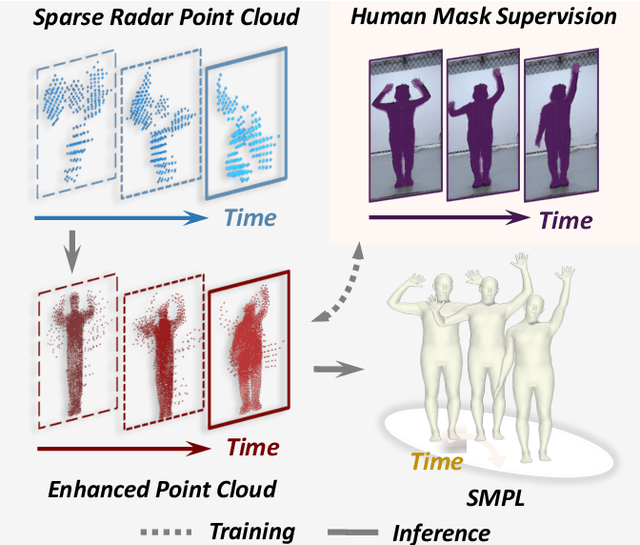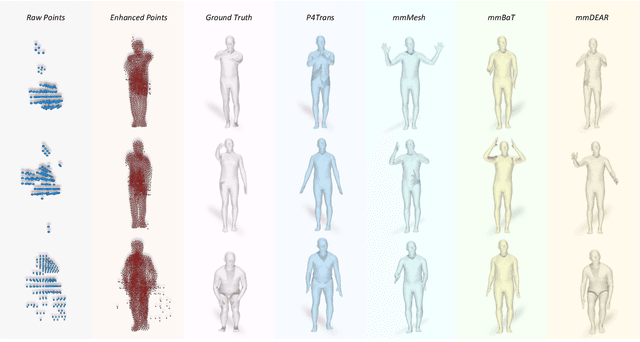Songpengcheng Xia
RadarLLM: Empowering Large Language Models to Understand Human Motion from Millimeter-wave Point Cloud Sequence
Apr 14, 2025Abstract:Millimeter-wave radar provides a privacy-preserving solution for human motion analysis, yet its sparse point clouds pose significant challenges for semantic understanding. We present Radar-LLM, the first framework that leverages large language models (LLMs) for human motion understanding using millimeter-wave radar as the sensing modality. Our approach introduces two key innovations: (1) a motion-guided radar tokenizer based on our Aggregate VQ-VAE architecture that incorporates deformable body templates and masked trajectory modeling to encode spatiotemporal point clouds into compact semantic tokens, and (2) a radar-aware language model that establishes cross-modal alignment between radar and text in a shared embedding space. To address data scarcity, we introduce a physics-aware synthesis pipeline that generates realistic radar-text pairs from motion-text datasets. Extensive experiments demonstrate that Radar-LLM achieves state-of-the-art performance across both synthetic and real-world benchmarks, enabling accurate translation of millimeter-wave signals to natural language descriptions. This breakthrough facilitates comprehensive motion understanding in privacy-sensitive applications like healthcare and smart homes. We will release the full implementation to support further research on https://inowlzy.github.io/RadarLLM/.
Suite-IN++: A FlexiWear BodyNet Integrating Global and Local Motion Features from Apple Suite for Robust Inertial Navigation
Apr 01, 2025



Abstract:The proliferation of wearable technology has established multi-device ecosystems comprising smartphones, smartwatches, and headphones as critical enablers for ubiquitous pedestrian localization. However, traditional pedestrian dead reckoning (PDR) struggles with diverse motion modes, while data-driven methods, despite improving accuracy, often lack robustness due to their reliance on a single-device setup. Therefore, a promising solution is to fully leverage existing wearable devices to form a flexiwear bodynet for robust and accurate pedestrian localization. This paper presents Suite-IN++, a deep learning framework for flexiwear bodynet-based pedestrian localization. Suite-IN++ integrates motion data from wearable devices on different body parts, using contrastive learning to separate global and local motion features. It fuses global features based on the data reliability of each device to capture overall motion trends and employs an attention mechanism to uncover cross-device correlations in local features, extracting motion details helpful for accurate localization. To evaluate our method, we construct a real-life flexiwear bodynet dataset, incorporating Apple Suite (iPhone, Apple Watch, and AirPods) across diverse walking modes and device configurations. Experimental results demonstrate that Suite-IN++ achieves superior localization accuracy and robustness, significantly outperforming state-of-the-art models in real-life pedestrian tracking scenarios.
mmDEAR: mmWave Point Cloud Density Enhancement for Accurate Human Body Reconstruction
Mar 04, 2025



Abstract:Millimeter-wave (mmWave) radar offers robust sensing capabilities in diverse environments, making it a highly promising solution for human body reconstruction due to its privacy-friendly and non-intrusive nature. However, the significant sparsity of mmWave point clouds limits the estimation accuracy. To overcome this challenge, we propose a two-stage deep learning framework that enhances mmWave point clouds and improves human body reconstruction accuracy. Our method includes a mmWave point cloud enhancement module that densifies the raw data by leveraging temporal features and a multi-stage completion network, followed by a 2D-3D fusion module that extracts both 2D and 3D motion features to refine SMPL parameters. The mmWave point cloud enhancement module learns the detailed shape and posture information from 2D human masks in single-view images. However, image-based supervision is involved only during the training phase, and the inference relies solely on sparse point clouds to maintain privacy. Experiments on multiple datasets demonstrate that our approach outperforms state-of-the-art methods, with the enhanced point clouds further improving performance when integrated into existing models.
EnvPoser: Environment-aware Realistic Human Motion Estimation from Sparse Observations with Uncertainty Modeling
Dec 13, 2024



Abstract:Estimating full-body motion using the tracking signals of head and hands from VR devices holds great potential for various applications. However, the sparsity and unique distribution of observations present a significant challenge, resulting in an ill-posed problem with multiple feasible solutions (i.e., hypotheses). This amplifies uncertainty and ambiguity in full-body motion estimation, especially for the lower-body joints. Therefore, we propose a new method, EnvPoser, that employs a two-stage framework to perform full-body motion estimation using sparse tracking signals and pre-scanned environment from VR devices. EnvPoser models the multi-hypothesis nature of human motion through an uncertainty-aware estimation module in the first stage. In the second stage, we refine these multi-hypothesis estimates by integrating semantic and geometric environmental constraints, ensuring that the final motion estimation aligns realistically with both the environmental context and physical interactions. Qualitative and quantitative experiments on two public datasets demonstrate that our method achieves state-of-the-art performance, highlighting significant improvements in human motion estimation within motion-environment interaction scenarios.
360Recon: An Accurate Reconstruction Method Based on Depth Fusion from 360 Images
Nov 28, 2024



Abstract:360-degree images offer a significantly wider field of view compared to traditional pinhole cameras, enabling sparse sampling and dense 3D reconstruction in low-texture environments. This makes them crucial for applications in VR, AR, and related fields. However, the inherent distortion caused by the wide field of view affects feature extraction and matching, leading to geometric consistency issues in subsequent multi-view reconstruction. In this work, we propose 360Recon, an innovative MVS algorithm for ERP images. The proposed spherical feature extraction module effectively mitigates distortion effects, and by combining the constructed 3D cost volume with multi-scale enhanced features from ERP images, our approach achieves high-precision scene reconstruction while preserving local geometric consistency. Experimental results demonstrate that 360Recon achieves state-of-the-art performance and high efficiency in depth estimation and 3D reconstruction on existing public panoramic reconstruction datasets.
Suite-IN: Aggregating Motion Features from Apple Suite for Robust Inertial Navigation
Nov 12, 2024



Abstract:With the rapid development of wearable technology, devices like smartphones, smartwatches, and headphones equipped with IMUs have become essential for applications such as pedestrian positioning. However, traditional pedestrian dead reckoning (PDR) methods struggle with diverse motion patterns, while recent data-driven approaches, though improving accuracy, often lack robustness due to reliance on a single device.In our work, we attempt to enhance the positioning performance using the low-cost commodity IMUs embedded in the wearable devices. We propose a multi-device deep learning framework named Suite-IN, aggregating motion data from Apple Suite for inertial navigation. Motion data captured by sensors on different body parts contains both local and global motion information, making it essential to reduce the negative effects of localized movements and extract global motion representations from multiple devices.
Learning-based Traversability Costmap for Autonomous Off-road Navigation
Jun 12, 2024



Abstract:Traversability estimation in off-road terrains is an essential procedure for autonomous navigation. However, creating reliable labels for complex interactions between the robot and the surface is still a challenging problem in learning-based costmap generation. To address this, we propose a method that predicts traversability costmaps by leveraging both visual and geometric information of the environment. To quantify the surface properties like roughness and bumpiness, we introduce a novel way of risk-aware labelling with proprioceptive information for network training. We validate our method in costmap prediction and navigation tasks for complex off-road scenarios. Our results demonstrate that our costmap prediction method excels in terms of average accuracy and MSE. The navigation results indicate that using our learned costmaps leads to safer and smoother driving, outperforming previous methods in terms of the highest success rate, lowest normalized trajectory length, lowest time cost, and highest mean stability across two scenarios.
SMART: Scene-motion-aware human action recognition framework for mental disorder group
Jun 07, 2024



Abstract:Patients with mental disorders often exhibit risky abnormal actions, such as climbing walls or hitting windows, necessitating intelligent video behavior monitoring for smart healthcare with the rising Internet of Things (IoT) technology. However, the development of vision-based Human Action Recognition (HAR) for these actions is hindered by the lack of specialized algorithms and datasets. In this paper, we innovatively propose to build a vision-based HAR dataset including abnormal actions often occurring in the mental disorder group and then introduce a novel Scene-Motion-aware Action Recognition Technology framework, named SMART, consisting of two technical modules. First, we propose a scene perception module to extract human motion trajectory and human-scene interaction features, which introduces additional scene information for a supplementary semantic representation of the above actions. Second, the multi-stage fusion module fuses the skeleton motion, motion trajectory, and human-scene interaction features, enhancing the semantic association between the skeleton motion and the above supplementary representation, thus generating a comprehensive representation with both human motion and scene information. The effectiveness of our proposed method has been validated on our self-collected HAR dataset (MentalHAD), achieving 94.9% and 93.1% accuracy in un-seen subjects and scenes and outperforming state-of-the-art approaches by 6.5% and 13.2%, respectively. The demonstrated subject- and scene- generalizability makes it possible for SMART's migration to practical deployment in smart healthcare systems for mental disorder patients in medical settings. The code and dataset will be released publicly for further research: https://github.com/Inowlzy/SMART.git.
TON-VIO: Online Time Offset Modeling Networks for Robust Temporal Alignment in High Dynamic Motion VIO
Mar 19, 2024Abstract:Temporal misalignment (time offset) between sensors is common in low cost visual-inertial odometry (VIO) systems. Such temporal misalignment introduces inconsistent constraints for state estimation, leading to a significant positioning drift especially in high dynamic motion scenarios. In this article, we focus on online temporal calibration to reduce the positioning drift caused by the time offset for high dynamic motion VIO. For the time offset observation model, most existing methods rely on accurate state estimation or stable visual tracking. For the prediction model, current methods oversimplify the time offset as a constant value with white Gaussian noise. However, these ideal conditions are seldom satisfied in real high dynamic scenarios, resulting in the poor performance. In this paper, we introduce online time offset modeling networks (TON) to enhance real-time temporal calibration. TON improves the accuracy of time offset observation and prediction modeling. Specifically, for observation modeling, we propose feature velocity observation networks to enhance velocity computation for features in unstable visual tracking conditions. For prediction modeling, we present time offset prediction networks to learn its evolution pattern. To highlight the effectiveness of our method, we integrate the proposed TON into both optimization-based and filter-based VIO systems. Simulation and real-world experiments are conducted to demonstrate the enhanced performance of our approach. Additionally, to contribute to the VIO community, we will open-source the code of our method on: https://github.com/Franky-X/FVON-TPN.
Thermal-NeRF: Neural Radiance Fields from an Infrared Camera
Mar 15, 2024



Abstract:In recent years, Neural Radiance Fields (NeRFs) have demonstrated significant potential in encoding highly-detailed 3D geometry and environmental appearance, positioning themselves as a promising alternative to traditional explicit representation for 3D scene reconstruction. However, the predominant reliance on RGB imaging presupposes ideal lighting conditions: a premise frequently unmet in robotic applications plagued by poor lighting or visual obstructions. This limitation overlooks the capabilities of infrared (IR) cameras, which excel in low-light detection and present a robust alternative under such adverse scenarios. To tackle these issues, we introduce Thermal-NeRF, the first method that estimates a volumetric scene representation in the form of a NeRF solely from IR imaging. By leveraging a thermal mapping and structural thermal constraint derived from the thermal characteristics of IR imaging, our method showcasing unparalleled proficiency in recovering NeRFs in visually degraded scenes where RGB-based methods fall short. We conduct extensive experiments to demonstrate that Thermal-NeRF can achieve superior quality compared to existing methods. Furthermore, we contribute a dataset for IR-based NeRF applications, paving the way for future research in IR NeRF reconstruction.
 Add to Chrome
Add to Chrome Add to Firefox
Add to Firefox Add to Edge
Add to Edge